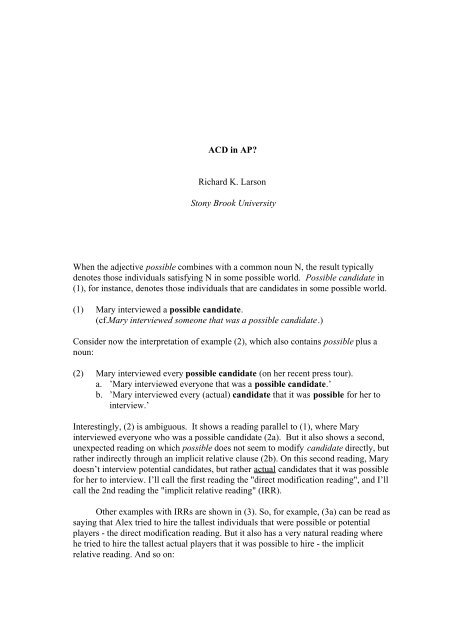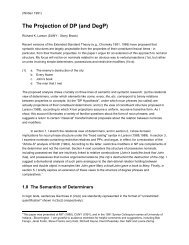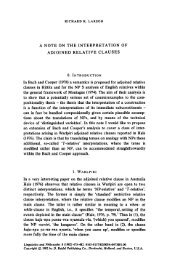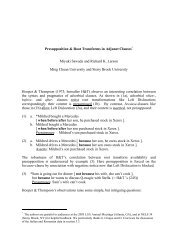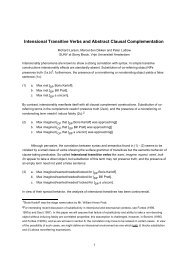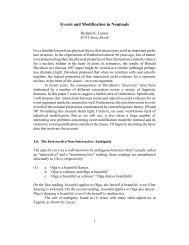ACD in AP? Richard K. Larson Stony Brook University When the ...
ACD in AP? Richard K. Larson Stony Brook University When the ...
ACD in AP? Richard K. Larson Stony Brook University When the ...
You also want an ePaper? Increase the reach of your titles
YUMPU automatically turns print PDFs into web optimized ePapers that Google loves.
<strong>ACD</strong> <strong>in</strong> <strong>AP</strong>?<br />
<strong>Richard</strong> K. <strong>Larson</strong><br />
<strong>Stony</strong> <strong>Brook</strong> <strong>University</strong><br />
<strong>When</strong> <strong>the</strong> adjective possible comb<strong>in</strong>es with a common noun N, <strong>the</strong> result typically<br />
denotes those <strong>in</strong>dividuals satisfy<strong>in</strong>g N <strong>in</strong> some possible world. Possible candidate <strong>in</strong><br />
(1), for <strong>in</strong>stance, denotes those <strong>in</strong>dividuals that are candidates <strong>in</strong> some possible world.<br />
(1) Mary <strong>in</strong>terviewed a possible candidate.<br />
(cf.Mary <strong>in</strong>terviewed someone that was a possible candidate.)<br />
Consider now <strong>the</strong> <strong>in</strong>terpretation of example (2), which also conta<strong>in</strong>s possible plus a<br />
noun:<br />
(2) Mary <strong>in</strong>terviewed every possible candidate (on her recent press tour).<br />
a. ’Mary <strong>in</strong>terviewed everyone that was a possible candidate.’<br />
b. ’Mary <strong>in</strong>terviewed every (actual) candidate that it was possible for her to<br />
<strong>in</strong>terview.’<br />
Interest<strong>in</strong>gly, (2) is ambiguous. It shows a read<strong>in</strong>g parallel to (1), where Mary<br />
<strong>in</strong>terviewed everyone who was a possible candidate (2a). But it also shows a second,<br />
unexpected read<strong>in</strong>g on which possible does not seem to modify candidate directly, but<br />
ra<strong>the</strong>r <strong>in</strong>directly through an implicit relative clause (2b). On this second read<strong>in</strong>g, Mary<br />
doesn’t <strong>in</strong>terview potential candidates, but ra<strong>the</strong>r actual candidates that it was possible<br />
for her to <strong>in</strong>terview. I’ll call <strong>the</strong> first read<strong>in</strong>g <strong>the</strong> "direct modification read<strong>in</strong>g", and I’ll<br />
call <strong>the</strong> 2nd read<strong>in</strong>g <strong>the</strong> "implicit relative read<strong>in</strong>g" (IRR).<br />
O<strong>the</strong>r examples with IRRs are shown <strong>in</strong> (3). So, for example, (3a) can be read as<br />
say<strong>in</strong>g that Alex tried to hire <strong>the</strong> tallest <strong>in</strong>dividuals that were possible or potential<br />
players - <strong>the</strong> direct modification read<strong>in</strong>g. But it also has a very natural read<strong>in</strong>g where<br />
he tried to hire <strong>the</strong> tallest actual players that it was possible to hire - <strong>the</strong> implicit<br />
relative read<strong>in</strong>g. And so on:
(3) a. Alex tried to hire <strong>the</strong> tallest possible players.<br />
b. Alice sampled all possible foods.<br />
c. Brenda pursued every conceivable lead.<br />
In this paper, I explore implicit relative read<strong>in</strong>gs, propos<strong>in</strong>g that <strong>the</strong>y are produced by a<br />
process very similar to Antecedent Conta<strong>in</strong>ed Deletion (<strong>ACD</strong>), as discussed by Sag<br />
(1976), Williams (1977), May (1985) and many o<strong>the</strong>rs. As I hope to show, this<br />
analysis both sheds light on <strong>the</strong> IRR phenomenon and provides an extension of <strong>ACD</strong><br />
<strong>in</strong>to an <strong>in</strong>terest<strong>in</strong>g new doma<strong>in</strong>.<br />
1.0 Restrictions on IRRs<br />
We beg<strong>in</strong> by observ<strong>in</strong>g two important, and <strong>in</strong>itially puzzl<strong>in</strong>g lexical restrictions on<br />
IRRs; one a restriction on <strong>the</strong> choice of adjective and <strong>the</strong> o<strong>the</strong>r on <strong>the</strong> choice of<br />
determ<strong>in</strong>er.<br />
Notice first of all that although possible and certa<strong>in</strong> -able adjectives license<br />
IRRs, o<strong>the</strong>r semantically similar adjectives like potential and probable do not (4):<br />
(4) Mary sampled every potential/probable food.<br />
’Mary sampled everyth<strong>in</strong>g that was potentially/probably a food.’<br />
*’Mary sampled every food that it was possible/probable to sample’ (IRR)<br />
Fur<strong>the</strong>rmore, note that although IRRs are licensed by universal determ<strong>in</strong>ers like<br />
every or all, or by a superlative as <strong>in</strong> (3a), o<strong>the</strong>r determ<strong>in</strong>ers do not seem to sanction<br />
<strong>the</strong> read<strong>in</strong>g. Compare (5):<br />
(3a) Alex tried to hire <strong>the</strong> tallest possible players.<br />
(cf. Alex tried to hire <strong>the</strong> tallest players that it was possible to hire.)<br />
(5) Mary <strong>in</strong>terviewed a/no/three/more/ a taller possible candidate(s).<br />
(≠ Mary <strong>in</strong>terviewed a/no/three/more candidate(s) that it was possible to<br />
<strong>in</strong>terview.)<br />
These lexical restrictions on IRRs appear idiosyncratic at first. On fur<strong>the</strong>r<br />
reflection, however, we notice <strong>the</strong>re are o<strong>the</strong>r <strong>in</strong>dependent differences between <strong>the</strong><br />
adjectives and determ<strong>in</strong>ers <strong>in</strong> question. Observe that one difference between <strong>the</strong><br />
adjective possible and it’s counterparts potential and probable is that <strong>the</strong> former allows<br />
an <strong>in</strong>f<strong>in</strong>itival clausal complement, whereas <strong>the</strong> latter do not (6a,b)<br />
(6) a. It is possible [PRO to <strong>in</strong>terview that candidate].<br />
b. *It is potential/probable [PRO to <strong>in</strong>terview that candidate].
Fur<strong>the</strong>rmore, note that <strong>the</strong> relevant Ds have <strong>the</strong> property of permitt<strong>in</strong>g an A to occur<br />
post-nom<strong>in</strong>ally; this is not so with <strong>the</strong> o<strong>the</strong>r determ<strong>in</strong>ers (7a,b):<br />
(7) a. Mary sampled every/all/ <strong>the</strong> sweetest food(s) possible.<br />
b. *Mary sampled a/no/three/more food(s) possible.<br />
2.0 A Promotion Analysis<br />
Let us now observe two additional relevant facts. On its implicit relative read<strong>in</strong>g, (2) is<br />
synonymous with (8), <strong>in</strong> which <strong>the</strong> adjective appears postnom<strong>in</strong>ally. In fact (8) is<br />
unambiguous, hav<strong>in</strong>g only <strong>the</strong> IRR read<strong>in</strong>g, and lack<strong>in</strong>g <strong>the</strong> direct modification<br />
read<strong>in</strong>g.<br />
(2) Mary <strong>in</strong>terviewed every possible candidate.<br />
(8) Mary <strong>in</strong>terviewed every candidate possible.<br />
(≠ Mary <strong>in</strong>terviewed every potential candidate)<br />
Fur<strong>the</strong>rmore, (8) itself appears to be an elliptical version of (9), which conta<strong>in</strong>s a<br />
postnom<strong>in</strong>al adjective with an <strong>in</strong>f<strong>in</strong>itival complement:<br />
(9) Mary <strong>in</strong>terviewed every candidate [ possible for her to <strong>in</strong>terview t ]<br />
These po<strong>in</strong>ts suggest that (2), on its IRR, might actually derive from a source<br />
equivalent to (9), where <strong>the</strong> A orig<strong>in</strong>ates postnom<strong>in</strong>ally and is subsequently fronted,<br />
and where <strong>the</strong> adjective takes an <strong>in</strong>f<strong>in</strong>itival complement that rema<strong>in</strong>s elliptical:<br />
(10) Mary <strong>in</strong>terviewed every possible candidate [ t [ for her to <strong>in</strong>terview t ]]<br />
This analysis would account for <strong>the</strong> synonymy among (9), (8) and (2) on its IRR. (2)<br />
is synonymous with (9) because it literally derives from it; and (8) is synonymous with<br />
(2) because it’s just an elliptical version of (9).<br />
The promotion analysis would also account for our two restrictions on IRRs.<br />
S<strong>in</strong>ce <strong>the</strong> prenom<strong>in</strong>al adjective orig<strong>in</strong>ates <strong>in</strong> postnom<strong>in</strong>al position, we expect that only<br />
determ<strong>in</strong>ers allow<strong>in</strong>g postnom<strong>in</strong>al adjectives would allow IRRs. So universal<br />
determ<strong>in</strong>ers would permit <strong>the</strong> read<strong>in</strong>g s<strong>in</strong>ce <strong>the</strong>y permit a postnom<strong>in</strong>al adjective, but<br />
determ<strong>in</strong>ers like some or most would not. Fur<strong>the</strong>rmore, s<strong>in</strong>ce <strong>the</strong> relativized position<br />
(t) occurs <strong>in</strong>side a clausal complement to <strong>the</strong> adjective, only adjectives select<strong>in</strong>g<br />
clausal complements would be expected to allow IRRs. So possible would allow such<br />
a read<strong>in</strong>g s<strong>in</strong>ce it takes a nonf<strong>in</strong>ite complement, but potential and probable would not.
If this syntactic account of <strong>the</strong> implicit relative read<strong>in</strong>g is correct, it immediately<br />
raises <strong>the</strong> question of <strong>the</strong> direct modification read<strong>in</strong>g, and how it is structurally<br />
represented. Without go<strong>in</strong>g <strong>in</strong>to details, it appears that when <strong>the</strong> adjective has <strong>the</strong><br />
direct modification read<strong>in</strong>g it occupies a structurally different site, one that is closer to<br />
<strong>the</strong> noun. The easiest way to see this is with examples like (11a-c) <strong>in</strong> which two<br />
adjectives are present and <strong>in</strong> which both read<strong>in</strong>gs are simultaneously observed:<br />
(11) a. Mary <strong>in</strong>terviewed every possible potential candidate.<br />
(= Mary <strong>in</strong>terviewed every potential candidate possible for her to <strong>in</strong>terview.)<br />
b. Mary <strong>in</strong>terviewed every potential candidate possible.<br />
c. Mary <strong>in</strong>terviewed every possible possible candidate.<br />
(= Mary <strong>in</strong>terviewed every possible candidate possible for her to <strong>in</strong>terview.)<br />
d. Mary <strong>in</strong>terviewed every possible candidate possible.<br />
Notice fur<strong>the</strong>r that <strong>in</strong> examples like (11a, c) with a sequence of two prenom<strong>in</strong>al<br />
adjectives, <strong>in</strong>tuition tells us that <strong>the</strong> first adjective has <strong>the</strong> implicit relative read<strong>in</strong>g<br />
whereas <strong>the</strong> second has <strong>the</strong> direct modification read<strong>in</strong>g. In o<strong>the</strong>r words <strong>the</strong> situation<br />
appears to be as <strong>in</strong> (12):<br />
(12) Mary <strong>in</strong>terviewed<br />
IRR DM<br />
every possible [ potential/possible candidate ] [ t [ for her to <strong>in</strong>terview t ] ]<br />
3.0 <strong>ACD</strong> and <strong>the</strong> Elliptical Complement<br />
An important question so far left open by this approach is how <strong>the</strong> content of <strong>the</strong><br />
elliptical complement clause is determ<strong>in</strong>ed with IRRs. The examples <strong>in</strong> (2) and (3c)<br />
show that this content is derived, at least <strong>in</strong> part, from <strong>the</strong> conta<strong>in</strong><strong>in</strong>g clause. Thus<br />
possible is understood as possible for her to <strong>in</strong>terview <strong>in</strong> (2), whereas it is understood<br />
as possible for her to sample <strong>in</strong> (3c), and so on:<br />
(2) Mary <strong>in</strong>terviewed every possible candidate<br />
(cf. Mary <strong>in</strong>terviewed every candidate possible for her to <strong>in</strong>terview.)<br />
(3c) Alice sampled all possible foods.<br />
(cf. Alice sampled all foods possible for her to sample.)<br />
I want to suggest that reconstruction of <strong>the</strong> elliptical clause is a variant of what occurs<br />
<strong>in</strong> A(ntecedent) C(onta<strong>in</strong>ed) D(eletion), a phenomenon that has been widely<br />
discussed <strong>in</strong> <strong>the</strong> literature.
3.1 <strong>ACD</strong> with an Elliptical VP<br />
<strong>ACD</strong> comes <strong>in</strong> number of different forms. A typical example is (13), <strong>in</strong> which an<br />
elliptical VP occurs <strong>in</strong>side <strong>the</strong> matrix VP serv<strong>in</strong>g as its reconstruction source:<br />
(13) Mary [VP <strong>in</strong>terviewed every candidate she could [ VP Ø ]].<br />
(cf. Mary <strong>in</strong>terviewed every candidate she could <strong>in</strong>terview.)<br />
Under proposals by Sag (1976) and May (1985), (13) has <strong>the</strong> approximate structure <strong>in</strong><br />
(14a) and <strong>the</strong> content of <strong>the</strong> elliptical VP is recovered <strong>in</strong> two steps. First, <strong>the</strong> object<br />
undergoes quantifier rais<strong>in</strong>g (QR) at LF (14b). The elliptical VP <strong>the</strong>n reconstructs from<br />
<strong>the</strong> matrix VP, which no longer conta<strong>in</strong>s it (14c).<br />
(14) a. Mary PST [VP <strong>in</strong>terview [DP every candidate [OPi she could [VP Ø ] ]] ]<br />
b. [DPi every candidate [OPi she could [VP Ø ] ]] Mary PST [ VP <strong>in</strong>terview ti ]<br />
QUANTIFIER RAISING<br />
c. [DPi every candidate [OPi she could [VP <strong>in</strong>terview ti ] ]] RECONSTRUCT VP<br />
Mary PST [VP <strong>in</strong>terview t i ]<br />
The result is a logical form with <strong>the</strong> appropriate <strong>in</strong>terpretation.<br />
3.2 <strong>ACD</strong> with an Elliptical CP<br />
This standard form of <strong>ACD</strong> example exhibits <strong>the</strong> <strong>in</strong>teraction of quantifier rais<strong>in</strong>g with<br />
VP ellipsis. A less familiar form shows <strong>the</strong> <strong>in</strong>teraction of quantifier rais<strong>in</strong>g with CP<br />
ellipsis. Consider (15a-c), a class of cases first noted (to my knowledge) by J-R<br />
Vergnaud (1975). 1 Notice that <strong>in</strong> each case what is elliptical, and what is reconstructed<br />
from <strong>the</strong> conta<strong>in</strong><strong>in</strong>g matrix, is an entire clause:<br />
(15) a. Mary <strong>in</strong>terviewed everyone you thought [CP Ø ].<br />
(cf. Mary <strong>in</strong>terviewed everyone you thought that she would <strong>in</strong>terview t.)<br />
b. Alice <strong>in</strong>vited no one you’d imag<strong>in</strong>e [CP Ø ] to <strong>the</strong> party.<br />
(cf. Alice <strong>in</strong>vited no one that you would imag<strong>in</strong>e<br />
that she would <strong>in</strong>vite t to <strong>the</strong> party.)<br />
c. Max saw everyone I claimed [CP Ø ].<br />
(cf. Max saw everyone I claimed that Mary saw t.)<br />
These can be derived by a process basically identical to that <strong>in</strong> (14). The underly<strong>in</strong>g<br />
structure is roughly as <strong>in</strong> (16a). Once aga<strong>in</strong>, <strong>the</strong> object undergoes quantifier rais<strong>in</strong>g at<br />
LF (16b). The elliptical CP <strong>the</strong>n reconstructs from <strong>the</strong> matrix clause (16c).<br />
1I am grateful to D. Sportiche for this reference; see also Häik (1984).
(16) a. [CP Mary PST <strong>in</strong>terview [DP every candidate [OPi you thought [CP Ø ] ]] ]<br />
b. [DPi every candidate [OPi you thought [CP Ø ] ]] [CP Mary PST <strong>in</strong>terview ti ]<br />
QUANTIFIER RAISING<br />
c. [DPi every candidate [OPi you thought [CP Mary PST <strong>in</strong>terview ti ]]]<br />
[CP Mary PST <strong>in</strong>terview ti ]<br />
RECONSTRUCT CP<br />
Although <strong>the</strong> issue is not entirely clear to me, <strong>the</strong> form of ellipsis <strong>in</strong>volved <strong>in</strong><br />
this second set of cases appears to be Null Complement Anaphora, which permits a<br />
clausal complement to be implicit (see Hankamer and Sag 1976 and Grimshaw 1979).<br />
As (17a-c) show, <strong>the</strong> verbs <strong>in</strong> (15) are ones permitt<strong>in</strong>g NCA. NCA is also available<br />
with possible, and <strong>the</strong> o<strong>the</strong>r adjectives licens<strong>in</strong>g IRRs, as shown <strong>in</strong> (18):<br />
(17) a. Did Mary <strong>in</strong>terview Lewis?<br />
I th<strong>in</strong>k (that Mary <strong>in</strong>terviewed Lewis).<br />
b. Did she <strong>in</strong>vite his cell mates to <strong>the</strong> reunion?<br />
I imag<strong>in</strong>e (that she <strong>in</strong>vited his cell mates).<br />
c. Did Mary also see Aunt Eunice <strong>the</strong>re?<br />
She claims (that she saw Aunt Eunice <strong>the</strong>re).<br />
(18) Did Mary <strong>in</strong>terview that candidate?<br />
It’s possible/conceivable/?imag<strong>in</strong>able (that she <strong>in</strong>terviewed that candidate).<br />
3.3 <strong>ACD</strong> with Possible<br />
Suppose now that when possible has an IRR it orig<strong>in</strong>ates post-nom<strong>in</strong>ally with an<br />
empty clausal complement licensed by Null Complement Anaphora. Suppose fur<strong>the</strong>r<br />
that at Logical Form (LF) possible reconstructs to its postnom<strong>in</strong>al position. Under this<br />
proposal, (2) has a representation as <strong>in</strong> (19a). The quantified object raises at LF, as<br />
shown <strong>in</strong> (19b). CP can <strong>the</strong>n reconstruct from <strong>the</strong> matrix clause, result<strong>in</strong>g <strong>in</strong> (19c):<br />
(19) a. [CP Mary PST <strong>in</strong>terview [DP every candidate [OPi possible [CP Ø ] ]] ]<br />
b. [DPi every candidate [OPi possible [CP Ø ] ]] [CP Mary PST <strong>in</strong>terview ti ]<br />
QUANTIFIER RAISING<br />
c. [DPi every candidate [OPi possible [CP for Mary to <strong>in</strong>terview ti ]]]<br />
[CP Mary PST <strong>in</strong>terview ti ]<br />
RECONSTRUCT CP<br />
This derivation is nearly parallel to <strong>the</strong> previous one and appears to yield a logical<br />
form with <strong>the</strong> correct <strong>in</strong>terpretation. The only difference is that <strong>in</strong> <strong>the</strong> derivation given,
<strong>the</strong> f<strong>in</strong>ite matrix clause <strong>in</strong> (19c) reconstructs as a nonf<strong>in</strong>ite clause. This assumption is<br />
necessary <strong>in</strong> order to capture <strong>the</strong> mean<strong>in</strong>g of <strong>the</strong> sentence correctly, on its IRR. Mary<br />
<strong>in</strong>terviewed every possible candidate is not appropriately rendered as Mary<br />
<strong>in</strong>terviewed every candidate that it is possible that she <strong>in</strong>terviewed, with literal copy<strong>in</strong>g<br />
of f<strong>in</strong>ite for f<strong>in</strong>ite. Instead, as we have noted, what we need is someth<strong>in</strong>g like Mary<br />
<strong>in</strong>terviewed every candidate that it is possible for her to <strong>in</strong>terview.<br />
Reconstruction of a nonf<strong>in</strong>ite clause from a f<strong>in</strong>ite one appears to be a possibility<br />
made available by Null Complement Anaphora, as shown by examples like (20a-c). 2<br />
Although <strong>the</strong> source clause is f<strong>in</strong>ite, it appears necessary <strong>in</strong> each case to assume that<br />
<strong>the</strong> reconstructed clause is nonf<strong>in</strong>ite (<strong>in</strong>f<strong>in</strong>itival or subjunctive): 3<br />
(20) Can Gwen lift 100 lbs?<br />
a. I believe it’s (im)possible.<br />
(cf. It’s (im)possible for Gwen to lift 100 lbs.)<br />
b. Yes, but it isn’t easy.<br />
(cf. It isn’t easy for Gwen to lift 100 lbs.)<br />
c. Should <strong>the</strong> K<strong>in</strong>g abdicate?<br />
We consider it preferable.<br />
(cf. We consider it preferable<br />
for <strong>the</strong> K<strong>in</strong>g to abdicate/that <strong>the</strong> K<strong>in</strong>g should abdicate.)<br />
Fur<strong>the</strong>rmore, <strong>the</strong> ability to reconstruct a nonf<strong>in</strong>ite complement seems to be<br />
<strong>in</strong>dependently attested <strong>in</strong> <strong>ACD</strong> examples like (21a,b), which are similar to (15a-c)<br />
given earlier:<br />
(21) a. Max did everyth<strong>in</strong>g you said Ø.<br />
(cf. Max did everyth<strong>in</strong>g you said that he did.<br />
and: Max did everyth<strong>in</strong>g you said to do. )<br />
b. I did everyth<strong>in</strong>g you asked me Ø.<br />
(cf. I did everyth<strong>in</strong>g you asked me to do)<br />
Thus if this is correct, <strong>the</strong>n it appears that <strong>the</strong> differences between <strong>the</strong> form of <strong>ACD</strong><br />
observed <strong>in</strong> standard examples like (13), and those observed <strong>in</strong> <strong>the</strong> IRRs of adjectives,<br />
2NCA also appears able to alter <strong>the</strong> illoqutionary force of a complement and to <strong>in</strong>sert a<br />
complement izer:<br />
(i) a. I wonder whe<strong>the</strong>r John went to Paris<br />
I imag<strong>in</strong>e (that John went to Paris)<br />
b. John went to Paris.<br />
Really? I wonder (whe<strong>the</strong>r John did go to Paris).<br />
3It is attractive to view this change as a form of what Fiengo and May (1993) refer to as<br />
"vehicle change", where certa<strong>in</strong> features are allowed to vary between <strong>the</strong> source and <strong>the</strong><br />
reconstructed element. A typical example of "vehicle change" is <strong>the</strong> reconstruction of a proper<br />
name as a bound pronoun.
may be attributable to <strong>the</strong> different forms of ellipsis <strong>in</strong>volved: VP Ellipsis <strong>in</strong> <strong>the</strong> first<br />
case and Null Complement Anaphora <strong>in</strong> <strong>the</strong> second.<br />
3.4 Possible for x to... Versus Possible for pro to...<br />
A consistent assumption made here has been that <strong>the</strong> proper gloss of <strong>the</strong> IRR is as <strong>in</strong><br />
(22a), which conta<strong>in</strong>s a pronoun bound to <strong>the</strong> subject. One might question this and ask<br />
whe<strong>the</strong>r <strong>in</strong> fact <strong>the</strong> right gloss isn’t (22b), where <strong>the</strong> subject of <strong>the</strong> reconstructed clause<br />
is small pro, a free pronoun with <strong>in</strong>def<strong>in</strong>ite reference.<br />
(22) Mary <strong>in</strong>terviewed every possible candidate<br />
a. ’Mary <strong>in</strong>terviewed every candidate possible for her to <strong>in</strong>terview’<br />
b. ’Mary <strong>in</strong>terviewed every candidate possible pro to <strong>in</strong>terview’<br />
(i.e., ’ possible for anyone to <strong>in</strong>terview’)<br />
Although <strong>the</strong> judgments are subtle, scope appears to give evidence for <strong>the</strong> (22a) gloss.<br />
Consider first (23a); this exhibits <strong>the</strong> standard ambiguity <strong>in</strong> which three<br />
managers can take scope over every candidate (23b) or every candidate can take scope<br />
over three managers (23c):<br />
(23) a. Three managers <strong>in</strong>terviewed every candidate.<br />
b. 3 > ∀ (same 3 <strong>in</strong>terviewers for each candidate)<br />
c. ∀ > 3 (each candidate gets 3, potentially different, <strong>in</strong>terviewers)<br />
To my ear, however, (24a) is not similarly ambiguous on <strong>the</strong> implicit relative read<strong>in</strong>g<br />
of possible. In particular, although we can understand <strong>the</strong> same three managers<br />
<strong>in</strong>terview<strong>in</strong>g all <strong>the</strong> candidates (24b), we cannot understand all <strong>the</strong> candidates as<br />
gett<strong>in</strong>g different sets of three <strong>in</strong>terviewers (24c).<br />
(24) a. Three managers <strong>in</strong>terviewed every possible candidate. (IRR)<br />
b. 3 > ∀ √<br />
c. ∀ > 3 *<br />
A similar po<strong>in</strong>t is made by (25a), suggested to me by D. Sportiche. The use of<br />
different <strong>in</strong> <strong>the</strong> subject DP strongly favors a read<strong>in</strong>g where <strong>the</strong> object takes widest<br />
scope. Notice now that although this example is f<strong>in</strong>e with Direct Modification<br />
Read<strong>in</strong>g of possible (25b), <strong>the</strong> Implicit Relative Read<strong>in</strong>g does not seem to be available<br />
(25c):<br />
(25) a. A different manager <strong>in</strong>terviewed every possible candidate.<br />
b. Direct Modification Read<strong>in</strong>g √<br />
c. Implicit Relative Read<strong>in</strong>g *
These facts are correctly expla<strong>in</strong>ed if <strong>the</strong> reconstructed form <strong>in</strong> <strong>the</strong> IRR follows (22a)<br />
and not (22b). The miss<strong>in</strong>g read<strong>in</strong>gs will be excluded as proper b<strong>in</strong>d<strong>in</strong>g violations.<br />
Compare (26a,b), <strong>the</strong> logical forms correspond<strong>in</strong>g to read<strong>in</strong>gs (24b) and (24c),<br />
respectively. <strong>When</strong> <strong>the</strong> subject quantifier takes widest scope, as <strong>in</strong> (26a), it correctly<br />
b<strong>in</strong>ds <strong>the</strong> x variable <strong>in</strong>side <strong>the</strong> object quantifier. However, when <strong>the</strong> object quantifier<br />
takes widest scope, as <strong>in</strong> (26b), this variable fails to be bound, violat<strong>in</strong>g <strong>the</strong> proper<br />
b<strong>in</strong>d<strong>in</strong>g condition.<br />
(26) a. [three x : manager x] [every y : candidate y & possible for x to <strong>in</strong>terview y ]<br />
x <strong>in</strong>terviewed y<br />
b. *[every y : candidate y & possible for x to <strong>in</strong>terview y ] [three x : manager x]<br />
x <strong>in</strong>terviewed y<br />
If <strong>the</strong> reconstruction <strong>in</strong> (22b) were available to us, <strong>the</strong>n ceteris paribus noth<strong>in</strong>g would<br />
exclude <strong>the</strong> miss<strong>in</strong>g read<strong>in</strong>g. Both (27a) and (27b) appear to be fully well-formed:<br />
(27) a. [three x : manager x] [every y : candidate y & possible for pro to <strong>in</strong>terview y]<br />
x <strong>in</strong>terviewed y<br />
b. [every y : candidate y & possible for pro to <strong>in</strong>terview y] [three x : manager x]<br />
x <strong>in</strong>terviewed y<br />
Similar remarks apply to <strong>the</strong> contrast <strong>in</strong> (25). On <strong>the</strong> basis of <strong>the</strong>se data, I conclude that<br />
<strong>the</strong> reconstruction <strong>in</strong> (22a) is <strong>the</strong> correct one, and that <strong>the</strong> adjectival complement must<br />
conta<strong>in</strong> a bound pronoun.<br />
4.0 Extensions<br />
This analysis offered here appears to generalize to a range of additional data, although<br />
<strong>in</strong> each case <strong>in</strong>terest<strong>in</strong>g new questions & challenges arise.<br />
4.1 Argument Ellipsis<br />
Elliptical VPs are possible <strong>in</strong>side relatives <strong>in</strong> subject nom<strong>in</strong>als (28). In this case<br />
reconstruction appears straightforward, as shown <strong>in</strong> (29). Basically one just copies <strong>the</strong><br />
VP:<br />
(28) Every candidate that could Ø ordered spaghetti.<br />
(29) a. Every candidate [OPi that ti could [VP Ø ] ] PST [VP order spaghetti].<br />
b. Every candidate [OPi that ti could [VP order spaghetti] ]<br />
PST [VP order spaghetti].<br />
RECONSTRUCT VP
This process has been referred to <strong>in</strong> <strong>the</strong> literature as "argument ellipsis" (Kennedy<br />
1994).<br />
Someth<strong>in</strong>g very similar appears to be available with elliptical CPs like (30), and<br />
with possible when <strong>the</strong> latter takes an IRR <strong>in</strong> subject position. Consider (31a). On<br />
reflection, this example can be seen to have a read<strong>in</strong>g very close to (28), so that our<br />
understand<strong>in</strong>g of every possible candidate <strong>in</strong> (30) is someth<strong>in</strong>g like "every candidate<br />
who could possibly order spaghetti".<br />
(30) [Every candidate you said Ø ] ordered spaghetti,<br />
(cf. Every candidate you said t ordered spaghetti ordered spaghetti.)<br />
(31) a. Every possible candidate ordered spaghetti. (= (28) on one read<strong>in</strong>g)<br />
b. [CP [DP every candidate [OPi possible [CP Ø ] ]] PST order spaghetti ]<br />
However, <strong>the</strong> analysis of (31) is more complex than (28). Whereas <strong>the</strong> ellipsis site is<br />
not antecedent-conta<strong>in</strong>ed <strong>in</strong> (28), it is antecedent-conta<strong>in</strong>ed <strong>in</strong> (31), as one can see by<br />
exam<strong>in</strong><strong>in</strong>g (31b). This means that, unlike <strong>the</strong> analysis of (28), <strong>the</strong> analysis of (31a) must<br />
appeal to quantifier rais<strong>in</strong>g, both to move [CP Ø ] outside its conta<strong>in</strong><strong>in</strong>g clause, as shown<br />
<strong>in</strong> (32a), and to provide a variable (ti) for OPi to b<strong>in</strong>d after reconstruction, as shown <strong>in</strong><br />
(32b):<br />
(32) a. [CP [DP every candidate [OPi possible [CP Ø ] ]] PST order spaghetti ]<br />
b. [DP every candidate [OPi possible [CP Ø ] ]] [CP ti PST order spaghetti ]<br />
c. [DPi every candidate [OPi possible [CP ti to order spaghetti ] ]]<br />
[CP ti PST spaghetti ]<br />
There is a fur<strong>the</strong>r <strong>in</strong>terest<strong>in</strong>g complexity with (31a). Notice once aga<strong>in</strong> that we<br />
want <strong>the</strong> reconstructed clause to be nonf<strong>in</strong>ite (nontensed), not f<strong>in</strong>ite. We want <strong>the</strong><br />
equivalent of (33a), not that of (33b):<br />
(33) a. Every candidate such that it was possible for her/him to order spaghetti<br />
ordered spaghetti.<br />
b. *Every candidate such that it was possible that he/she ordered spaghetti<br />
ordered spaghetti.<br />
However if we reconstruct a nonf<strong>in</strong>ite clause, we are, <strong>in</strong> effect, reconstruct<strong>in</strong>g a variable<br />
<strong>in</strong> a non-case marked position at LF, someth<strong>in</strong>g that is not permitted at PF:<br />
(34) *Every candidate possible for t to order spaghetti ordered spaghetti.<br />
Thus if we analyze <strong>the</strong> IRR read<strong>in</strong>g of (28) as obta<strong>in</strong>ed by <strong>ACD</strong>, <strong>the</strong>n we appear to be<br />
committed to <strong>the</strong> view that <strong>the</strong> case-mark<strong>in</strong>g requirement on variables is purely a PF<br />
phenomenon, and not part of <strong>the</strong> essential def<strong>in</strong>ition of a variable, as has sometimes
een assumed (cf. Chomsky 1982).<br />
4.2 French -Able As<br />
Häik (1984) notes read<strong>in</strong>gs for certa<strong>in</strong> French -able adjective constructions that appear<br />
similar to <strong>the</strong> IRRs reported here:<br />
(35) Jean a épousé une femme <strong>in</strong>croyable<br />
Jean Aux married a woman unbelievable<br />
’ Jean married a woman such that it’s unbelievable (of him) that he married her’<br />
Häik states that <strong>in</strong>croyable (on <strong>the</strong> relevant read<strong>in</strong>g) applies to <strong>the</strong> whole clause, so that<br />
what’s unbelievable is that John married <strong>the</strong> woman <strong>in</strong> question. Häik offers a<br />
derivation as <strong>in</strong> (36), where <strong>the</strong> DP conta<strong>in</strong><strong>in</strong>g <strong>in</strong>croyable raises at LF, and <strong>the</strong> where<br />
<strong>the</strong> adjectives <strong>the</strong>n raises out of <strong>the</strong> DP and applies to its conta<strong>in</strong><strong>in</strong>g clause.<br />
(36) [<strong>in</strong>croyable] [une femme t ] Jean a épousé t<br />
Häik’s proposal encounters a number of serious problems, however.<br />
First, on <strong>the</strong> structure <strong>in</strong> (36), possible is a modifier of <strong>the</strong> sentence; if so, why<br />
was it generated <strong>in</strong> DP <strong>in</strong> <strong>the</strong> first place? Why was it projected <strong>in</strong> construction with an<br />
element to which it bears no <strong>the</strong>matic/semantic relation?<br />
Second, and even more seriously, on <strong>the</strong> proposal <strong>in</strong> (36), possible is not a<br />
modifier of femme. But truth-conditionally, <strong>AP</strong> must restrict femme; <strong>the</strong> woman must<br />
be one that it is impossible to believe Jean married. So, compositionally, (36) appears<br />
quite problematic<br />
By contrast, an <strong>ACD</strong> derivation parallel to that given for English possible appears<br />
to capture <strong>the</strong> mean<strong>in</strong>g of (35) correctly, without <strong>the</strong> problems encountered by Häik.<br />
The derivation is shown <strong>in</strong> (37):<br />
(37) a. [CP Jean PST épousé [DP une femme [OPi <strong>in</strong>croyable [CP Ø ]]] ]<br />
b. [DPi une femme [OPi <strong>in</strong>croyable [CP Ø ] ]] [CP Jean PST épousé ti ]<br />
c. [DPi une femme [OPi <strong>in</strong>croyable [CP Jean INFL épouser ti] ]]<br />
[CP Jean PST épousé ti ]<br />
Here <strong>in</strong>croyable takes a clausal complement that is reconstructed after QR breaks up<br />
<strong>the</strong> conta<strong>in</strong>ment relation. Thus <strong>in</strong>croyable applies to a clause identical <strong>in</strong> relevant<br />
respects to <strong>the</strong> matrix, but it doesn’t need to climb outside <strong>the</strong> DP <strong>in</strong> order to do so.<br />
Fur<strong>the</strong>rmore, "unbelievable for him to have married" ends up modify<strong>in</strong>g <strong>the</strong> noun<br />
femme, as desired.
4.3 Wrong <strong>ACD</strong>?<br />
Häik (1984) also notes facts <strong>in</strong>volv<strong>in</strong>g <strong>the</strong> adjective wrong that may fall under <strong>the</strong> <strong>ACD</strong><br />
account. (Right works <strong>the</strong> same) Consider (38), which means ’Peter talked to <strong>the</strong> man<br />
he wasn’t supposed to talk to’.<br />
(38) Peter talked to <strong>the</strong> wrong man.<br />
Wrong-ness is <strong>in</strong>variably assessed along some dimension, which is always present,<br />
whe<strong>the</strong>r explicitly or implicitly <strong>When</strong> wrong takes an <strong>in</strong>f<strong>in</strong>itival complement, this<br />
complement supplies <strong>the</strong> dimension (39a,b).<br />
(39) a. Peter was wrong.<br />
b. Peter was wrong [ PRO to talk to Jason ].<br />
We might thus analyze (38) (on <strong>the</strong> relevant read<strong>in</strong>g) as <strong>in</strong> (40), conta<strong>in</strong><strong>in</strong>g a hidden<br />
<strong>in</strong>f<strong>in</strong>itival "dimension complement" with an empty CP that is reconstructed:<br />
(40) a. [CP Peter PST talk to [DP <strong>the</strong> [ OPi wrong [CP Ø ]] man] ]<br />
b. [DPi <strong>the</strong> [ OPi wrong [CP Ø ]] man] [CP Peter PST talk to ti ]<br />
c. [DPi <strong>the</strong> [ OPi wrong [CP for Peter INFL talk to ti ]] man]<br />
[CP Peter PST talk to ti ]<br />
And cases like (41a) from Häik would <strong>the</strong>n represent argument ellipsis on our account.<br />
(41a) means someth<strong>in</strong>g like ’<strong>the</strong> man who wasn’t supposed to kill Peter killed Peter’. It<br />
would be derived as <strong>in</strong> (41b-c)<br />
(41) a. The wrong man killed Peter.<br />
b. [DP <strong>the</strong> [ wrong [CP Ø ]] man] killed Peter.<br />
c. [DPi <strong>the</strong> [ OPi wrong [CP ti INFL kill Peter ]] man]] [CP ti PST kill Peter ]<br />
4.3.1 Scope Ambiguities<br />
There is a fur<strong>the</strong>r parallel between <strong>the</strong> wrong cases, and cases of <strong>ACD</strong>. <strong>Larson</strong> and<br />
May (1987) note that <strong>ACD</strong> reconstruction can be ambiguous <strong>in</strong> embedded contexts. For<br />
example, (42a) allows ei<strong>the</strong>r <strong>the</strong> embedded VP or <strong>the</strong> matrix VP to function as<br />
reconstruction source (cf. (42b,c), respectively):<br />
(42) John wanted to visit every city you did [VP Ø ].<br />
a. ’John wanted to visit every city you visited’<br />
b. ’John wanted to visit every city you wanted to visit’<br />
This result is derived by assign<strong>in</strong>g (42) <strong>the</strong> underly<strong>in</strong>g structure <strong>in</strong> (43), and by<br />
permitt<strong>in</strong>g two possible reconstruction scenarios. If DP raises and reconstructs with<strong>in</strong>
<strong>the</strong> embedded clause, as shown <strong>in</strong> (44), we get <strong>the</strong> read<strong>in</strong>g <strong>in</strong> (42). If DP raises to <strong>the</strong><br />
matrix clause and reconstructs <strong>the</strong>re, as shown <strong>in</strong> (45), we get <strong>the</strong> read<strong>in</strong>g <strong>in</strong> (42b):<br />
(43) John [VP wanted [PRO to [VP visit [DP every city you did [VP Ø ]]]]]<br />
(44) a. John [VP wanted [[DPi every city you did [VP Ø ]] [PRO to [VP visit ti]]]]<br />
b. John [VP wanted [[DPi every city you did [VP visit ti]] [PRO to [VP visit ti]]]]<br />
(45) a. [DPi every city you did [VP Ø ]] John [VP wanted [PRO to [VP visit ti]]]<br />
b. [DPi every city you did [VP want [PRO to [VP visit ti]]]<br />
John [VP wanted [PRO to [VP visit ti]]]<br />
Interest<strong>in</strong>gly, Häik (1984) notes what appears to be a similar case with wrong.<br />
Consider her (46). On reflection it, <strong>the</strong> sentence is ambiguous. On <strong>the</strong> one hand, John<br />
may believe that <strong>the</strong> person who killed Peter was <strong>the</strong> wrong person to do so. Perhaps<br />
he thought Max should do <strong>the</strong> job, but Felix did it <strong>in</strong>stead. That’s <strong>the</strong> read<strong>in</strong>g <strong>in</strong> (46a).<br />
On <strong>the</strong> o<strong>the</strong>r hand, John may simply be wrong <strong>in</strong> his belief about who committed<br />
murder. John believes Max to have killed Peter, when <strong>in</strong> fact it was Felix who was<br />
guilty. That’s <strong>the</strong> read<strong>in</strong>g <strong>in</strong> (46b).<br />
(46) John believes <strong>the</strong> wrong man to have killed Peter<br />
a. ’John believes a man to have killed Peter who was <strong>the</strong> wrong one to have<br />
killed Peter.<br />
b. ’John believes a man to have killed Peter who is <strong>the</strong> wrong one to believe to<br />
have killed Peter’<br />
These two read<strong>in</strong>gs can be given derivations parallel to those <strong>in</strong> (44) and (45). If <strong>the</strong><br />
wrong man raises and reconstructs <strong>the</strong> complement <strong>in</strong> <strong>the</strong> embedded clause, <strong>the</strong> result is<br />
(46a). If <strong>the</strong> wrong man raises to <strong>the</strong> matrix clause and reconstructs its complement<br />
<strong>the</strong>re, <strong>the</strong> result is (46b). So <strong>the</strong> analysis of (46) becomes fully parallel to that of (43).<br />
4.3.2 Problems<br />
Before conclud<strong>in</strong>g on too rosy a note, we should observe that <strong>the</strong> facts with possible<br />
and wrong do differ <strong>in</strong> important ways, so assimilation is not entirely straightforward.<br />
First, <strong>the</strong> Ds licens<strong>in</strong>g <strong>ACD</strong> with possible do not co-occur with wrong (47a); <strong>in</strong> fact<br />
wrong only seems to permit <strong>the</strong> def<strong>in</strong>ite determ<strong>in</strong>er (47b):<br />
(47) a. *Peter saw every wrong man/all wrong men<br />
b. *Peter saw a/each wrong man//many/two/ wrong men<br />
Second, wrong, unlike possible, cannot normally occur <strong>in</strong> postnom<strong>in</strong>al position. An<br />
example like (48), for <strong>in</strong>stance, is completely out:<br />
(48) *Peter saw <strong>the</strong> man wrong.
I can only offer tentative suggestions at this po<strong>in</strong>t regard<strong>in</strong>g this behavior. The<br />
restriction of wrong and right to <strong>the</strong> def<strong>in</strong>ite article <strong>the</strong> seems to be associated with <strong>the</strong><br />
fact that, semantically, <strong>the</strong>se adjectives behave ra<strong>the</strong>r like superlatives, <strong>in</strong> so far as <strong>the</strong>y<br />
denote <strong>the</strong> extreme po<strong>in</strong>ts of <strong>the</strong> scale of accuracy. Just as <strong>the</strong> superlative strongly<br />
prefers a def<strong>in</strong>ite, so do wrong and right. In effect <strong>the</strong>n this represents an extra feature<br />
of <strong>the</strong>ir semantics.<br />
The question regard<strong>in</strong>g <strong>the</strong>ir <strong>in</strong>ability to occur postnom<strong>in</strong>ally is more <strong>in</strong>terest<strong>in</strong>g.<br />
The crucial feature of postnom<strong>in</strong>al position is that, for nearly all adjectives,<br />
complements are permitted only <strong>in</strong> postnom<strong>in</strong>al position. Thus, on <strong>the</strong> whole, it is only<br />
adjectives that can orig<strong>in</strong>ate postnom<strong>in</strong>ally that can take a complement and thus show<br />
an IRR. Interest<strong>in</strong>gly, <strong>the</strong>re is one class of exception to this: tough-adjectives.<br />
Although <strong>the</strong>re are restrictions, tough-adjectives can appear prenom<strong>in</strong>ally with an<br />
<strong>in</strong>f<strong>in</strong>itive complement <strong>in</strong> cases like a tough-to-f<strong>in</strong>d item, or an easy-to-make mistake.<br />
Interest<strong>in</strong>gly, wrong and right are <strong>the</strong>mselves tough-adjectives, <strong>in</strong> cases like John was<br />
wrong for us <strong>in</strong>terview or Mary was right for us to recommend. Perhaps <strong>the</strong> two can be<br />
l<strong>in</strong>ked <strong>the</strong>n: perhaps wrong and right can take IRRs, despite not occurr<strong>in</strong>g<br />
postnom<strong>in</strong>ally, because <strong>the</strong>y are tough-adjectives. As such <strong>the</strong>y don’t need to occur<br />
postnom<strong>in</strong>ally <strong>in</strong> order to license a complement. These remarks are largely speculative,<br />
of course, and would need to be developed fur<strong>the</strong>r, but <strong>the</strong> general idea is clear enough.<br />
5.0 Conclusions<br />
In this paper we’ve exam<strong>in</strong>ed an ambiguity with <strong>the</strong> adjective possible, and <strong>in</strong> <strong>the</strong><br />
process of analyz<strong>in</strong>g it we have reached a number of tentative, but quite <strong>in</strong>terest<strong>in</strong>g<br />
conclusions:<br />
• As proposed by some of <strong>the</strong> earliest analyses <strong>in</strong> transformational grammar (Smith<br />
1964, Jacobs and Rosenbaum 1968), some prenom<strong>in</strong>al adjectives actually do orig<strong>in</strong>ate<br />
postnom<strong>in</strong>ally - <strong>in</strong> effect as reduced relative clauses.<br />
• Prenom<strong>in</strong>al adjectives occupy structurally different sites, depend<strong>in</strong>g on whe<strong>the</strong>r<br />
<strong>the</strong>y are understood as reduced relatives or direct N modifiers (see <strong>Larson</strong> (1998) for<br />
more on this). And one and <strong>the</strong> same adjective may occupy different sites, depend<strong>in</strong>g<br />
on its semantics.<br />
• <strong>ACD</strong> occurs with adjectives function<strong>in</strong>g as reduced relatives, much as it does<br />
with full relatives.<br />
• <strong>ACD</strong> can <strong>in</strong>volve <strong>the</strong> <strong>in</strong>teraction of quantifier rais<strong>in</strong>g and a number of different<br />
ellipsis operations - not only VP Ellipsis, but also Null Complement Anaphora.<br />
• <strong>ACD</strong> potentially extends to a variety of adjectival constructions, <strong>in</strong>clud<strong>in</strong>g<br />
counterparts from o<strong>the</strong>r languages (French) and o<strong>the</strong>r cases is English, like wrong and<br />
right, that show similar, but <strong>in</strong>terest<strong>in</strong>gly different properties than possible.
References<br />
Grimshaw, J. (1979) "Complement Selection and <strong>the</strong> Lexicon," L<strong>in</strong>guistic Inquiry 10:<br />
279-326.<br />
Häik, I. (1984) The Syntax of Operators. unpublished Ph.D. <strong>the</strong>sis. MIT.<br />
Häik, I. (1984) "Adjectives and Logical Form," unpublished abstract MIT.<br />
Hankamer, J. and I. Sag (1976) "Deep and Surface Anaphora," L<strong>in</strong>guistic Inquiry 7:<br />
391-428.<br />
Jacobs, R. and P. Rosenbaum (1968) English Transformational Grammar. Waltham,<br />
MA: G<strong>in</strong>n.<br />
Kennedy, C. (1994) "Argument-Conta<strong>in</strong>ed Ellipsis," L<strong>in</strong>guistics Research Center<br />
report series, Cowell College, UCSC, Santa Cruz.<br />
<strong>Larson</strong>, R. (1998) "Events and Modification <strong>in</strong> Nom<strong>in</strong>als," <strong>in</strong> D. Strolovitch and A.<br />
Lawson (eds.) Proceed<strong>in</strong>gs from Semantics and L<strong>in</strong>guistic Theory VIII. Ithaca: Cornell<br />
<strong>University</strong>.<br />
May, R. (1985) Logical Form: It’s Structure and Derivation. Cambridge: MIT Press.<br />
Sag, I (1976) Deletion and Logical Form. unpublished Ph.D. <strong>the</strong>sis. MIT.<br />
Smith, C. (1964) "Determ<strong>in</strong>ers and Relative Clauses <strong>in</strong> Generative Grammar,"<br />
Language 40: 37-52.<br />
Vergnaud, J. R. (1975) "La réduction du noeud S dans les relatives et les<br />
comparatives," Rapport de Recherches du Laboratoire d’Automatique Documentaire et<br />
L<strong>in</strong>guistique 5:106-129<br />
Williams, E. (1977) "Discourse and Logical Form," L<strong>in</strong>guistic Inquiry 8: 101-139.


